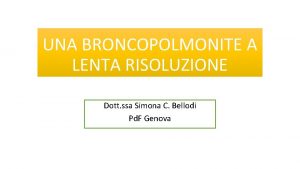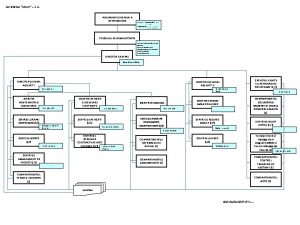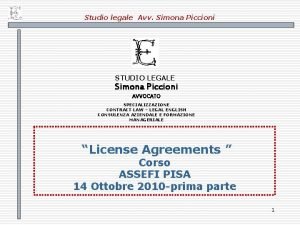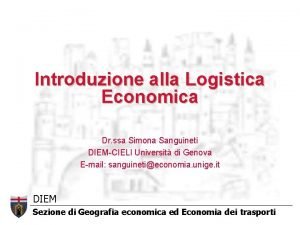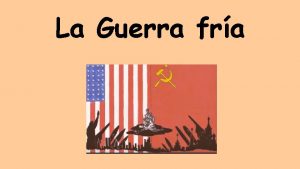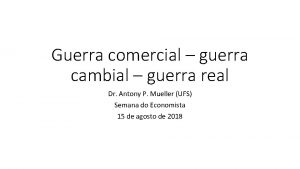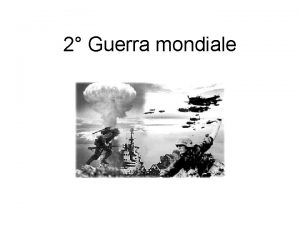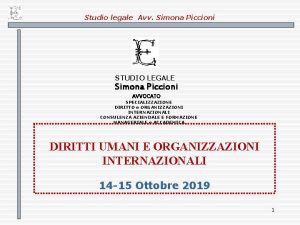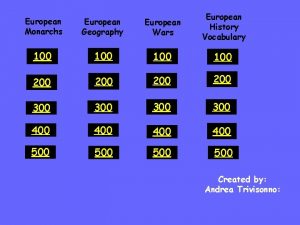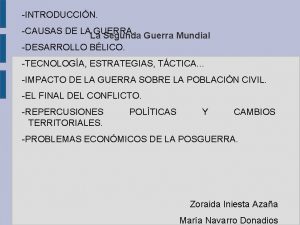INTRODUCTION TO EUROPEAN POLITICS Dr Simona Guerra simona




















- Slides: 20

INTRODUCTION TO EUROPEAN POLITICS Dr Simona Guerra simona. guerra@nottingham. ac. uk

KEYNOTE SPEECH The School of Politics and the Centre for the Study of European Governance present A keynote speech by Simon Duffin Head of Press UK Office of the European Parliament On the EP, the EU and the British press and the EU 2 -3/3. 30 pm @ C 16, Pope Building, Wednesday, 11 March 2009

POLICIES § WHY common policies – the European Policy Agenda § WHY AND HOW – range and diversity; regulatory emphasis; different degrees of EU policy involvement; patchy uncoordinate nature? , internal and external policies § CAP – (why? ) – redistributive, controversial, source of tension and disputes, difficult to reforms § CAP – and the neofunctionalist approach § Regional and Structural Policies – economic disparities, expanding, Europe of regions – and the intergovernmentalist approach

POLICIES § Since the Founding Treaties, MSs agreed on ‘internal tariffs, agriculture and ovs developments’ § Developed (spillover&subsidiarity): ü ü ü ‘Treaty obligations’ ‘Pressures to harmonise’ ‘Legislative pressures’ ‘Policy evolution and spillover’ ‘Institutional pressures’ ‘International law’ ‘Political initiatives’ ‘Public opinion’ ‘Internal pressures’ ‘External pressures’ ‘Emergencies or crisis’ (Bache and George 2006: 353 -377; Mc. Cormick 2008: 94 -118)

POLICIES § Range and diversity: many centred on ‘the promotion and defence of an internally free and externally protected market’ – but still barriers, interventionism/regulation – others on non-economic fields (foreign policy, defence, broadcasting, combating crime) § The regulatory emphasis: regulatory (rules governing behavior), redistributive (transfer financial resources) and distributive (allocate resources, BUT not from one side to the other) § Different degrees of EU policy involvement: No EU (Housing, Civil liberties…), Marginal EU (Health, Education, Defence, Social welfare), Shared (Regional, Competition, Environment, Working conditions, Energy, Transport, Cross -border crime…), Considerable EU (Market regulation, Monetary), Extensive (Trade, Agriculture, Fishing) § Patchy uncoordinated? : national/political differences (Nugent 2006: 383 -391)

COMMON AGRICULTURE POLICY (CAP) Why? § (Internal) First ‘redistributive’ policy; one of the four common policies that had its own Title in the Treaty of Rome § Important: both politically and economically (CAP and France (NL)) § ‘Despite the ‘supranational’ or common format, MSs’ preferences are the main factors driving this policy system’ (Bache and George 2006: 378 -402)

CAP DECISION-MAKING § European Commission and Agriculture Council § EC – draft the legislation (request of the Council or voluntary from the EC) § EP – just consultation (+ Committee of Agricultural Organisations in the EC – COPA, interest groups – European farmers, Committee of the Regions § Council – takes decisions (unanimity informally, but QMV formally) http: //europa. eu/pol/agr/index_en. htm (Cini 2007: 340 -355)

CAP as a ‘proxy’ of European Integration § Just negative integration? § ‘Entails positive entitlements to public assistance in the form of fixed prices and transfers’; ‘Negative restrictions on MSs’ § Based on (i) Market unity, (ii) Community preferences and (iii) Financial solidarity § ‘National systems of agricultural support became supranational’ (Rieger in Wallace, Wallace and Pollack 2005: 161 -190; Cini 2007: 340 -356)

CAP as a political rationale § Details of the policy not included in the Treaty of Rome § Agreed in 1958 that the CAP ‘would be based on a system of common prices (cereals, Germ vs. FR) § Basically, since then ‘it has remained the same’ § ‘Politically driven and defensive strategy to modernise European agriculture against the internal threat of an expanding industrial society and the external…of vigorous US competition’ (Bache and George 2006: 378 -402; Rieger in Wallace, Wallace and Pollack 2005: 161 -190)

THE MANSHOLT PLAN § 1968, restructuring agriculture § Encouraging farmers to leave (grants or pensions; cut of price levels), amalgamation of holdings § Domestic politics (FR, Germ) and internal pressures (enlargement: EI, DK and UK) § Farmers in the streets (1971) § 1972 -3 harvest; 1973 oil crisis (Bache and George 2006: 378 -402)

PERMUTATIONS OF THE CAP § External pressures (1980 s) – GATT and US (eschewing competition with the rest of the world; ‘quotas’) § Shift in policy: Mac. Sharry reform (1990 s) (direct support to farmers, individual direct payments, decoupling) - not so ‘innovative’ § Agenda 2000 (10 new regulations, environment, sustainability, multifunctionality, new reform plan in 2002, reformed in 2003 to avoid a clash with the WTO, Single Farm Payment – decoupled from production) § Challenges: Environmental issues (enlargements), Social dimension (equity) (Cini 2007: 340 -356)

Signing an agreement Brussels, 1 December 2008: Agriculture and Rural Development Commissioner Mariann Fischer Boel with Stephen Smith, Australian Minister for Foreign Affairs (agreement governing the wine trade between Australia and the EU) © European Union: http: //ec. europa. eu/avservices/download/photo_download_en. cfm? id=239711&type=4 Licensed for Reproduction only: http: //ec. europa. eu/avservices/about/index. cfm? sitelang=en&pagesection=about&page=copyright

CAP & NEOFUNCTIONALISM § Cultivated spillover (fixing prices, supporting more efficient farmers, new technologies, food surpluses, rationalisation) § Pressure for the adoption of other common policies (exchange rates) § But national gov’ts’ pressures (British rebate) § So, economic interests of gov’ts? (IG, LIG) § System of multi-level governance, impact of political, economic and global changes (Bache and George 2006: 378 -402)

REGIONAL POLICY § A European regional policy discussed (1961) § 1970 s: convergence towards a regional policy with the opposition of Britain, Thomson Report (agreement, 1975) § The 1988 Reform (on Structural Funds: concentration – obj. 1, 2, 3 and 4, programming, partnership and additionality) § The 1993 Reform and the Cohesion Fund § Post-2000 and Post-2006 (convergence, regional competitiveness and employment, European territorial co-operation) (Bache and George 2006: 456 -487)

Regions in the EU 9 May 2007: Commissioner Danuta Hübner at the Launch of 2007 -2013 European Structural Funds Programmes "Strong Regions - Building Bridges for Europe“ © European Union: http: //ec. europa. eu/commission_barroso/hubner/photos_en. htm Licensed for Reproduction Only: http: //ec. europa. eu/avservices/about/index. cfm? sitelang=en&pagesection=about&page =copyright

Cohesion Policy 2007 -2013 Convergence Regions Phasing-out Regions Phasing-in Regions Competitiveness and Employment Regions © European Union: http: //ec. europa. eu/regional_policy/atlas 2007/index_en. htm Licensed for REPRODUCTION ONLY: http: //ec. europa. eu/geninfo/legal_notices_en. htm

REGIONAL POLICY AND NATIONAL ACTORS § European Commission (redistributive) vs. Council (‘protecting MSs’ allocations and gov’s’ control over the distribution of funds’) § 1988 as turning point (because of the latest enlargement and preferences of the new MSs? ) § IG as the most explanatory (Bache and George 2006: 456 -487)

CAP & REGIONAL POLICY IN THE EU FINANCIAL FRAMEWORK § Since 1998 (up to then annual negotiations) the EU adopts multi-annual ‘financial perspectives’ § The Commission makes proposal, the Council and the EP negotiate agreements (custom duties, shares of harmonised VAT, contribution based on GNI, ceiling now set at 1. 24%) § EU budget 2009: Sustainable growth (45%); Natural Resources (31%); Competitiveness for growth and employment (11%); A global player (6%)… http: //ec. europa. eu/budget/index_en. htm

FINANCIAL FRAMEWORK 2007 -13 © European Union: http: //ec. europa. eu/budget/prior_future/fin_framework_en. htm Licensed for REPRODUCTION ONLY: http: //ec. europa. eu/geninfo/legal_notices_en. htm 18 December 2008: Commissioner Dalia Grybauskaitė signing the change in the Interinstitutional agreement for the 2009 EU budget during the European Parliament Plenary session in Strasbourg © European Union: http: //ec. europa. eu/commission_barroso/grybauskaite/photogallery_en. htm Licenced for REPRODUCTION ONLY: http: //ec. europa. eu/geninfo/legal_notices_en. htm

NEXT WEEK Internal policies II: § Economic and Monetary Union Ø Growth and Stability Pact § Social Policy
 Simona guerra
Simona guerra Ce inseamna profesor asociat
Ce inseamna profesor asociat Simona apotek
Simona apotek Costabel simona pediatra genova
Costabel simona pediatra genova Simona e pasquino analisi
Simona e pasquino analisi Bellodi simona
Bellodi simona Mersul stepat
Mersul stepat Simona borženská
Simona borženská Simona teighiu jurj
Simona teighiu jurj Simona rolli
Simona rolli Simona varga
Simona varga Simona karneckaite
Simona karneckaite Simona di stefano psicologa
Simona di stefano psicologa Simona piccioni
Simona piccioni Simona piccioni
Simona piccioni Simona misa
Simona misa Simona sanguineti
Simona sanguineti S somacescu
S somacescu Energetické suroviny
Energetické suroviny Simona stann
Simona stann Simona weber
Simona weber





